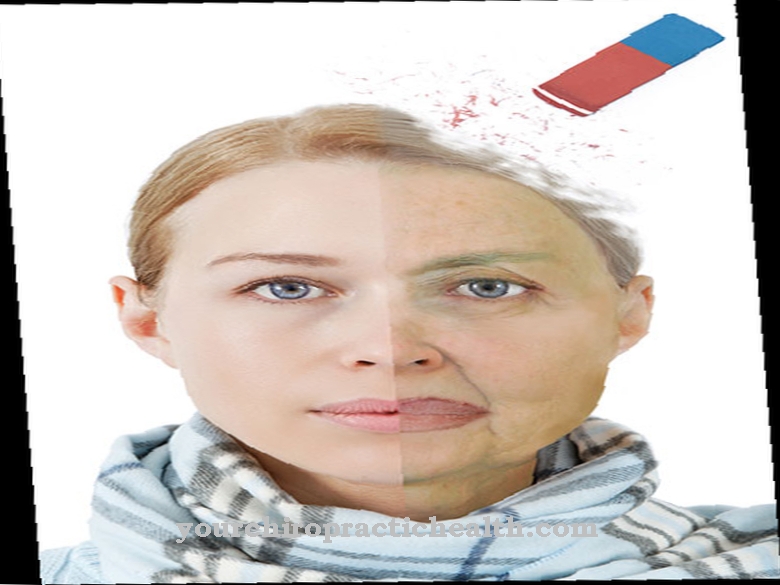The age-related macular degeneration, age-related macular degeneration or short AMD, is a progressive damage to the epithelial tissue (pigment epithelium) and the photoreceptors in the retina. The damage to the tissue leads to a loss of function and thus to a severe reduction in visual acuity (visual acuity = visual acuity) in old age. The following text deals with the definition, causes, diagnosis and course as well as the treatment and preventive measures of age-related macular degeneration.
What is age-related macular degeneration

Age-related macular degeneration is a disease of the retina (retina). In particular, it affects the place of sharpest vision, the macula lutea (also known as the “yellow spot”).
A malfunction of the pigment epithelium leads to the accumulation of metabolic products in the retina in age-related macular degeneration. This then forms so-called drusen, which lead to the destruction and dilution of the pigment epithelium that is common there. As a result, the neighboring photoreceptors are also impaired in their function.
Photoreceptors are light-sensitive sensory cells, whereby the cones are responsible for color stimuli and the rods for twilight vision or black-and-white vision. Age-related macular degeneration is a disease of older age and usually begins from the age of 60.
causes
Depending on the clinical appearance, a dry and a wet form of age-related macular degeneration are distinguished. The diagnosis is carried out by means of ophthalmoscopy, a reflection of the fundus and a visual field examination.
An Amsler grid test can also be carried out at home for the early detection of age-related macular degeneration. You can see a white grid on a black background or upside down. A point in the middle is fixed. If you see distorted lines, squares of different sizes, missing corners or blurred areas, you should consult an ophthalmologist as soon as possible.
More rarely, a fluorescence angiography is performed to diagnose age-related macular degeneration, in which a contrast agent is injected into a vein. Then the retina is photographed.
You can find your medication here
➔ Medicines for visual disturbances and eye complaintsSymptoms, ailments & signs
With this disease, patients primarily suffer from visual problems. The severity of the visual problems can be very different, but there is always a significantly reduced visual acuity. The patients can no longer see clearly, and contrasts can no longer be correctly recognized.
Vision is often distorted and very blurred, so that there are significant limitations and complications in everyday life. As the disease progresses, it can also lead to complete blindness in the patient. Visual problems can also lead to mental impairment or depression in some people.
The severe visual problems also increase the risk of injuries and accidents. If the disease is not treated, bleeding will occur and irreversible damage to the patient's retina will occur. Even with successful treatment with the help of a laser, a relapse can occur, so that the same symptoms reappear.
No further treatment or healing is possible. In some cases, the disease can also negatively affect color vision, so that the patient can no longer see different colors correctly. Color blindness can also occur.
Diagnosis & course
In the dry course of age-related macular degeneration, hard drusen that are sharply delimited and look yellowish appear. In the course of the disease, the number and size of the drusen increase, which can then unite to form an area. This leads to a decrease in vision and visual acuity.
The dry form of age-related macular degeneration shows a central scotoma (place of weakening) on the visual field examination. A more severe course of age-related macular degeneration is the wet form. This shows soft drusen with a pool of fluid under the pigment epithelium. This corresponds to a detachment of the pigment epithelium. The patients complain of sudden distorted vision (metamorphopsia) with a simultaneous decrease in visual acuity.
Furthermore, in this form of age-related macular degeneration, new vascular formations (neovasculariasations) are observed, which lead to further damage to the pigment epithelium and the photoreceptors. This damage is irreversible and can occur very quickly. Bleeding into the retina can occur.
Those affected only show a minimal peripheral field of vision and can only roughly orientate themselves in space. Reading is no longer possible. In this moist form of age-related macular degeneration, fluorescence angiography is performed to assess the formation of new vessels.
Complications
Age-related macular degeneration (AMD) occurs in two different forms, dry and wet AMD. The dry form is the one with the slower progression. Tiny deposits can be made out in the area of the macula, the tiny, only a few millimeters large zone of central vision, which gradually lead to an impairment of central vision.
The biggest complication that can be associated with dry AMD is the risk that it will develop into the wet form. This means that new blood vessels grow into the area of the macula, also known as the yellow spot, which, due to their leakage, cause bleeding into this area of the retina. The haemorrhage is accompanied by a progressive deterioration in the central focus and color vision.
So far, there is no known therapy for the treatment of dry AMD that goes beyond treating the symptoms. The level of probability that dry AMD will develop into wet AMD is independent of whether dry AMD was treated at an early stage. Other complications associated with the progression of one of the two forms of AMD are not known.
Two different therapeutic approaches are available for the treatment of wet AMD. On the one hand, the neurotransmitter VEGF is supposed to suppress the formation of new blood vessels and, on the other hand, laser technology can be used to obliterate the formation of new blood vessels.
When should you go to the doctor?
If changes in visual perception with a permanent character can be determined in the central visual field, it is advisable to have the changed visual perception clarified by an ophthalmologist as soon as possible. If the central field of vision is seen blurred despite glasses, the color contrast is reduced or there are distortions or even zones with total failure, there is a suspicion of developing age-related macular degeneration (AMD).
A self-test, the so-called Amsler grid test, can also be carried out with simple means to confirm the suspicion. It is a relatively close-meshed grid, which is formed from squares and has a clearly visible black point in the middle. The grid is easy to find on the Internet under the keyword "Amsler grid". The grid is viewed alternately with the left and right eye from a normal reading distance and the other eye is covered in each case.
If the point or individual squares of the grid appear distorted or disappear completely, there is a strong suspicion of AMD. In these cases, an ophthalmologist should be consulted immediately for clarification. If the suspicion is confirmed, the ophthalmologist can initiate therapy that can slow down or even stop the disease and that takes into account whether it is the more common dry or the less common wet form of AMD.
Doctors & therapists in your area
Treatment & Therapy
The treatment of age-related macular degeneration takes place depending on the dry or wet form. No intervention is currently possible for dry age-related macular degeneration. Visual aids such as illuminated magnifying glasses, magnifying glasses or television readers can be prescribed.
For the wet form of age-related macular degeneration, the progress of the formation of new vessels can be temporarily halted in the early stages. For this purpose, the newly formed vessels are laser coagulated. However, this success is short-lived. Often recurrences (relapses) of age-related macular degeneration occur within 2 years, which can then no longer be treated.
Drug therapy has so far remained unsuccessful. With photodynamic therapy, the development process of a moist form of age-related macular degeneration can be slowed down, but not stopped. A vascular toxic substance is injected intravenously. The toxic substances are only activated by laser light. The destructive formation of new blood vessels can be slowed down and the affected person will retain better eyesight for a longer period of time.
Outlook & forecast
Because of the macular degeneration, those affected mainly suffer from discomfort in the eyes. As a rule, visual acuity is significantly reduced so that those affected can only see indistinctly. The everyday life of the patient is made significantly more difficult by the macular degeneration. Contrasts can no longer be displayed correctly, so that the patient's quality of life is greatly reduced. In the worst case, it can lead to complete blindness. Macular degeneration often also has a negative impact on the person's color vision.
It is usually not possible to treat macular degeneration directly. In some cases, the symptoms can be corrected with a laser. However, this cannot rule out the possibility that the macular degeneration may relapse again. Unfortunately, no further corrections can be made. However, the symptoms can be limited relatively well by using visual aids. The life expectancy of the person affected is not restricted by the macular degeneration.
You can find your medication here
➔ Medicines for visual disturbances and eye complaintsprevention
Unfortunately, there are no preventive measures for age-related macular degeneration. If you notice distorted lines or a blurry image, you should consult an ophthalmologist at an early stage.
Aftercare
Age-related macular degeneration (AMD) is divided into the more common dry macular degeneration and the more rarely occurring wet macular degeneration. For both, early detection is more important than aftercare. If visual damage has already occurred as a result of age-related macular degeneration, this cannot be medically corrected. However, immediate treatment can preserve the remaining eyesight.
The dry macular degeneration proceeds slowly and insidiously over several decades. The earlier it is recognized, the better the treatment can be. The eye disease can ideally be stopped, but otherwise slowed down. Careful and regular monitoring of disease progression is essential in follow-up care.
With wet AMD, the process is rapid. It is associated with retinal damage. In order to interrupt the process of vision loss in age-related macular degeneration, doctors are increasingly trying to prevent vision loss through intravitreal medication in the vitreous humor under local anesthesia.
The numerous consequences of the wet form of age-related macular degeneration are serious. Eyesight is quickly lost without immediate treatment. Loss of vision already suffered cannot be repaired. As a result, if treatment is started too late, follow-up care can only consist in the afflicted being able to cope with life despite their lost vision.
You can do that yourself
There are no known self-help methods outside of medical or clinical treatment that could stop the progress of age-related macular degeneration (AMD) or even cure it. A combination of self-help measures with medical treatment methods can take place in a systemic treatment that is based on nutritional technology and requires the special cooperation of the patient.
To determine AMD, the so-called Amsler grid test can be carried out at any time as a self-help measure, by means of which everyone can recognize whether there is a high probability that they have AMD and how severely central vision is impaired. The Amsler grid can easily be found and accessed on the Internet. It consists of the image of a grid consisting of square fields with a clearly visible black point in the middle.
The grid is viewed from a normal reading distance with reading glasses - if necessary - alternately with the right and left eye, while the other eye is covered. If some squares - especially in the vicinity of the black point - and the point itself appear distorted or are not visible at all, there is a high probability of AMD with a dry or moist form.
For people with advanced central vision disorders, for example, films and videos or TV programs are helpful if they have acoustic descriptions of action ready on demand during the short pauses in dialogue to support them.


.jpg)
.jpg)

.jpg)





















